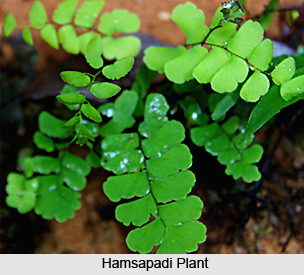Hansapadi is an Indian medicinal plant found throughout India at an altitude of 1200 m. It is an attractive small leafy fern and is also known as Adiantum lunuatum L. These plants usually occur in moist places on rocks and slopes of lower hills as well as on brown laterite soil or under shade near swamps.
 These Indian medicinal plants are used as medicinal purpose throughout the country. In Ayurvedic medicine the plant comprises the drug Hamsapadi and is used as an external application to relieve burns, poisonous affections and skin diseases, including leprosy. It is also included in several important compound preparations. The fronds, made into a plaster are applied to chronic gouty and other swellings and to chronic tumors; the juice of the fresh plant is applied to promote healing of wounds and abscesses. Burnt with oil, the fronds are used as an application to soothe itches.
These Indian medicinal plants are used as medicinal purpose throughout the country. In Ayurvedic medicine the plant comprises the drug Hamsapadi and is used as an external application to relieve burns, poisonous affections and skin diseases, including leprosy. It is also included in several important compound preparations. The fronds, made into a plaster are applied to chronic gouty and other swellings and to chronic tumors; the juice of the fresh plant is applied to promote healing of wounds and abscesses. Burnt with oil, the fronds are used as an application to soothe itches.
The roots of Adiantaceae or Hamsapadi are considered carminative, tonic, diuretic and useful for treating bilious complaints. They are also prescribed for strangury and for fever due to elephantiasis. A decoction of the roots is used to treat throat infections and febrile conditions in children and to treat discharge of blood in the urine (haematuria) among the Kondhs of southwestern Orissa. These people also use the root paste as an external application to promote healing of bone fractures. In Bhadrak District of Orissa the crushed plant is applied to treat flatulence.
The botanical name of this Indian medicinal plant is Adiantum philippense Burm and popularly known as Hamsapadi in Sanskrit, Goyalelata and Kalijhant in Bengali, Walking Maidenhair Fern in English, Hansapadi, Hansraj, Mubarakha and Mubarkhinipalo in Gujarati, hansapadi, kalijhant and paresiyavasan in Hindi, navalad in Kannada, Nilamparanta in Malayalam, Ghodkhuri, Hansraj, Kamsaraj and Ratkombada in Marathi, etc.



















